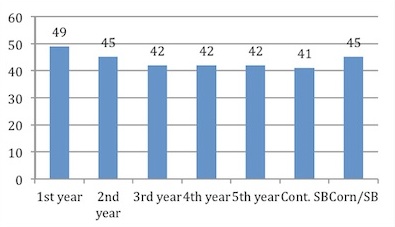With the late season, there are some low lying fields that were cropped to soybeans last year and may not be ready to plant for several weeks.
The original, and best plan would be to rotate to corn this year. But from a timing perspective, some might be considering to plant soybeans in those field in early June.
This brings up the question: What is the yield penalty for planting soybeans following soybean?
|
Figure 1: Impact of rotation on soybean yields in bushels per acre. (Univ. of Wisconsin) |
Several studies have looked at the impact on yield from following soybeans with soybeans that we can draw on for an answer.
A Canadian study showed that continuous soybeans yielded about 3 bu/acre less than soybeans following corn and about 5 bu/acre less than soybeans following a wheat corn rotation.
A Wisconsin study showed some similar results: first year soybeans averaged 53 bu/acre, while in the second year of soybeans, yields dropped to 47 bu/acre. In a corn soybean rotation, yields averaged 48 bu/acre.
In another Wisconsin and Minnesota study, first-year soybeans averaged 49 bu/acre, 45 bu/acre in a corn/soybean rotation and 45 bu/acre in the second year of soybeans, then dropped to 42 bu/acre in the fifth year (Figure 1).
The bottom line is that soybeans yield best when grown in a long rotation and might yield 4–6 bu/acre less in the second year, especially if they are already in a corn/soybean rotation.
Disease issues in some of these low-lying fields could be more severe, especially in no-till environments and some of these fields may be more responsive than average to fungicide applications.







Post a comment
Report Abusive Comment